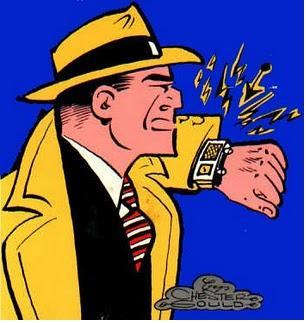The next big shift in IT's cycle will come strapped to our wrists.
We are already migrating into a landscape of people who are empowered with information-gathering and reporting devices. These portable devices, in order to be truly effective, require interaction with the cloud or the Internet. But today, these devices rely heavily on tethering, a trend that will not last given our insatiable demand for mobility and flexibility. Users, from top executives to students, will increasingly insist upon WiFi connectivity.
DIck Tracy Calling

Chester Gould set the bar high when he drew Dick Tracy and his high-tech wristwatch.
(Source: Wikipedia)
(Source: Wikipedia)
Police Detective Dick Tracy, as drawn in the popular comic, sported a highly functional tool -- his watch. This device, which looked very similar to any other watch, featured capabilities far beyond the technology of the day, including videoconferencing, big-data search, and navigational guidance. In fact, it had components that exist, in larger form factors, in today's tech world.
Rumors that Apple will be releasing a device akin to the Dick Tracy Watch are surfacingacross the web, although Apple has not confirmed these stories.
Apple stores stock bands for its popular Nano iPod, which many users sport similarly to a wristwatch. Fossil released the Abacus AU5005, a wrist PDA running Palm OS, but it never gained any market traction. First released in 2004, it's possible Fossil could rerelease Abacus with the recent advent of BlackBerry 10. (See: BlackBerry 10 Faces Enterprise, BYOD Hurdles.)
Almost three years ago, another big tech player cited the comic strip in a widely reported blog post. Carl Taussig, director of IS at HP Labs in Palo Alto, referred to a watch in development in a one-line description: “We call it a Dick Tracy Watch." Since he posted this in May 2010, the HP product cannot be far off.
Handy, Dandy Device

People can customize Pebble's watch face, apps, and other features, according to the developer.
(Source: Pebble)
(Source: Pebble)
Sony, which is a big company, has the SmartWatch, which lets wearers access text messages, emails, and status updates, as well as apps on Google Play.
One reason these intelligent, connected wristwatches will succeed is our evolving connectivity.
MediaTek, an off-brand smartphone manufacturer, is mounting a plan to release a no contract, $100-range smartphone. In fact, I've seen some reports that the smartphone market will settle into a $50, no-contract price.
Smartphones and other mobile devices built on an operating system with advanced connectivity options are becoming the norm, not the exception. Phones that look for WiFi, rather than defaulting to 3G/4G connectivity, are storming the market. As the saturation percentage increases, and as devices ship at a lower price point, business environments of all sizes will be challenged with wireless informal device support, also known as BYOD.
Corporate offices, traditionally protected by a hard firewall-based network edge, are being forced to recognize this micro army of devices. Incorporating the ad hoc user via tethered Bluetooth device or 802.x enabled WiFi is IT's reality. As I wrote recently, there are tools out there used solely to compromise networks via WiFi radio, tools that are accessible and free.
Understanding the impact of these devices in relation to governance, security, and accessibility requires a current look at adoptable and available technology.
Too often, when I broach this topic with clients, they greet me with understanding nods and placating statements. They get that "this is the future." Acknowledging that the future is here is rare. A real threat exists, not tomorrow, but today.
In nature, a tsunami builds far off the coast, spurred by an underwater shift in the landscape, far below the visible surface. On the horizon, you can't see any real change. Only after the massive wave has had time to build and gain momentum does the destructive force strike a coastline. Plummeting hardware costs, market innovators, user demand, and established standards constitute the digital plate shift -- and these events have already happened in our industry.
The tsunami of BYOD, in the form of inexpensive wearable tech, is about to hit the coastline of IT. Can your department swim?

No comments:
Post a Comment